
Bas-Rhin is a département in Alsace which is a part of the Grand Est super-region of France. The name means 'Lower Rhine', referring to its lower altitude among the two French Rhine departments: it is downstream of the Haut-Rhin department. Both belong to the European Upper Rhine region. It is, with the Haut-Rhin, one of the two departments of the traditional Alsace region which until 1871, also included the area now known as the Territoire de Belfort. The more populous and densely populated of the pair, it had 1,148,073 inhabitants in 2020. The prefecture is based in Strasbourg. The INSEE and Post Code is 67.
Falkenstein or Falckenstein may refer to:
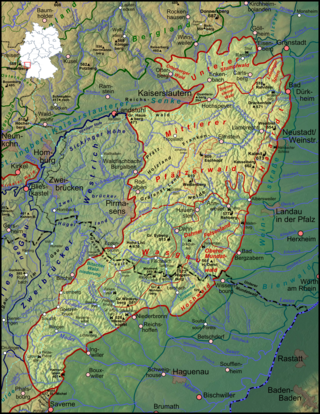
The Palatinate Forest, sometimes also called the Palatine Forest, is a low-mountain region in southwestern Germany, located in the Palatinate in the state of Rhineland-Palatinate. The forest is a designated nature park covering 1,771 km2 and its highest elevation is the Kalmit.
Bunter Pebble Beds is the name formerly given to a set of sandstone deposits within the New Red Sandstone containing rounded pebbles. They are thought to be alluvial deposits and, judging from the rounding of the mainly quartzite pebbles, to have resulted from prolonged transportation in a large and turbulent river, resulting in powerful abrasion.

Trifels Castle is a reconstructed medieval castle at an elevation of 500 m (1,600 ft) near the small town of Annweiler, in the Palatinate region of southwestern Germany. It is located high above the Queich valley within the Palatinate Forest on one peak of a red sandstone mountain split into three. Trifels Castle is on the peak of the Sonnenberg, and on both of the other two rock elevations there are castle ruins: Anebos Castle and Scharfenberg Castle.

Drachenfels Castle is a ruined hill castle near the village of Busenberg in the state of Rhineland-Palatinate. It lies within the German half of the Wasgau region, the southern part of the Palatinate Forest.

Lembach is a commune in the Bas-Rhin department and Grand Est region of north-eastern France.
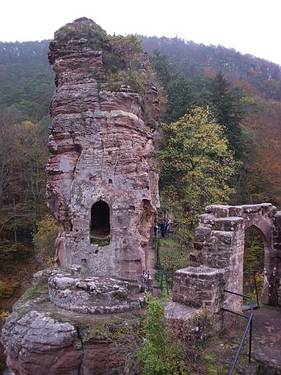
The Château de Frœnsbourg is a ruined French castle north west of the town of Lembach, within the Bas-Rhin département. It has been listed since 1898 as a monument historique by the French Ministry of Culture. It is partially a troglodyte structure, with two main buildings making up the rest of the structure.

Altdahn Castle is a castle ruin in the Palatinate Forest, the German part of the Wasgau region. It is located near the town of Dahn in Rhineland-Palatinate, Germany. It stands 337 metres (1,106 ft) above sea level (NN).

Berwartstein Castle is a castle in the Wasgau, the southern part of the Palatinate Forest in the state Rhineland-Palatinate in southwestern Germany. It was one of the rock castles that were part of defences of the Palatinate during the Middle Ages. This castle is noted in the publication Works of Preservation of Monuments of Rheinland-Pfalz, which was assembled and edited for the Ministry of Education and Culture. This states that the three prime examples of rock castles in the region are Drachenfels, Altdahn and Berwartstein, castles where the stairs, passages and rooms are carved out of the rock to form part of the accommodation essential to the defence of the castle. Although the Berwartstein appears more complete when compared to the ruins of neighbouring castles, it is only a restoration of the original rock castle. It is the only castle in the Palatinate that was rebuilt and re-inhabited after its demolition.
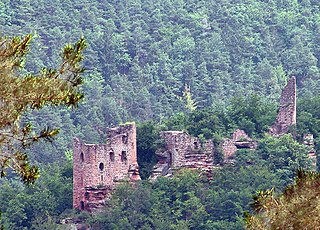
The Château du Wasigenstein is a ruined castle in the commune of Niedersteinbach in the Bas-Rhin département of France.
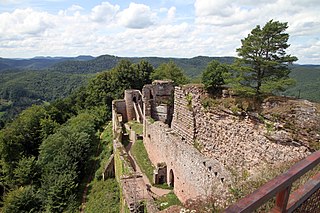
The castle of Neuscharfeneck is a ruin and a cultural monument above Ramberg and Dernbach on the territory of an exclave of Flemlingen in the district of Südliche Weinstraße in the west German state of Rhineland-Palatinate.

The Château du Nouveau-Windstein is a ruined castle located on a hill west of the commune of Windstein in the Bas-Rhin département of France.

A cave castle or grotto castle is a residential or refuge castle that has been built into a natural cave. It falls within the category of hill castles. Unlike other types, such castles can only be assaulted from the front, or by drilling through the rock above; the gateway is usually located in the middle of a rock face, which makes it much more difficult to penetrate. Archaeological discoveries have revealed that caves were used as places of refuge as early as the Stone Age. The first medieval cave castles emerged in the 11th and 12th centuries. In the 14th and 15th centuries this type became more widespread, especially in certain parts of France and Switzerland.

The Château de Hohenbourg is a ruined castle in the commune of Wingen, in the Bas-Rhin département of France. It has been listed since 1898 as a monument historique by the French Ministry of Culture.

The Dahner Felsenland, also referred to as the Dahn Rockland, is a landscape in the county of Südwestpfalz in the German federal state of Rhineland-Palatinate. It is located in the middle section of the Wasgau, which in turn forms the southern part of the Palatine Forest and the northern part of the Vosges in France. The Dahner Felsenland has numerous rock formations within the South Palatinate Climbing Area.
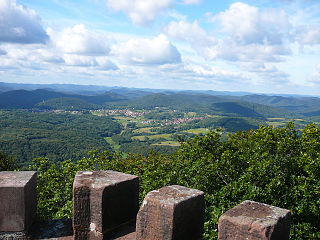
The Wasgau is a Franco-German hill range in the German state of Rhineland-Palatinate and the French departments of Bas-Rhin and Moselle. It is formed from the southern part of the Palatine Forest and the northern part of the Vosges mountains, and extends from the River Queich in the north over the French border to the Col de Saverne in the south.

The rock castle of Neudahn, in the southwestern Palatine Forest in the German state of Rhineland-Palatinate, is located at the northern end of an elongated ridge near the town of Dahn. The heart of the castle is situated on one of the sandstone rock outcrops that are typical of the Dahner Felsenland region.
The German Shoe Road is one of several tourist-oriented, themed routes in southern Rheinhessen and in the West Palatinate in the German state of Rhineland-Palatinate. It is a circular route of more than 300 km largely running within the Palatine Forest-North Vosges Biosphere Reserve often on scenic secondary roads.

Scharfenberg Castle, is the ruin of a medieval rock castle in the Palatine Forest in the German state of Rhineland-Palatinate. It is situated above the small South Palatine town of Annweiler.






















